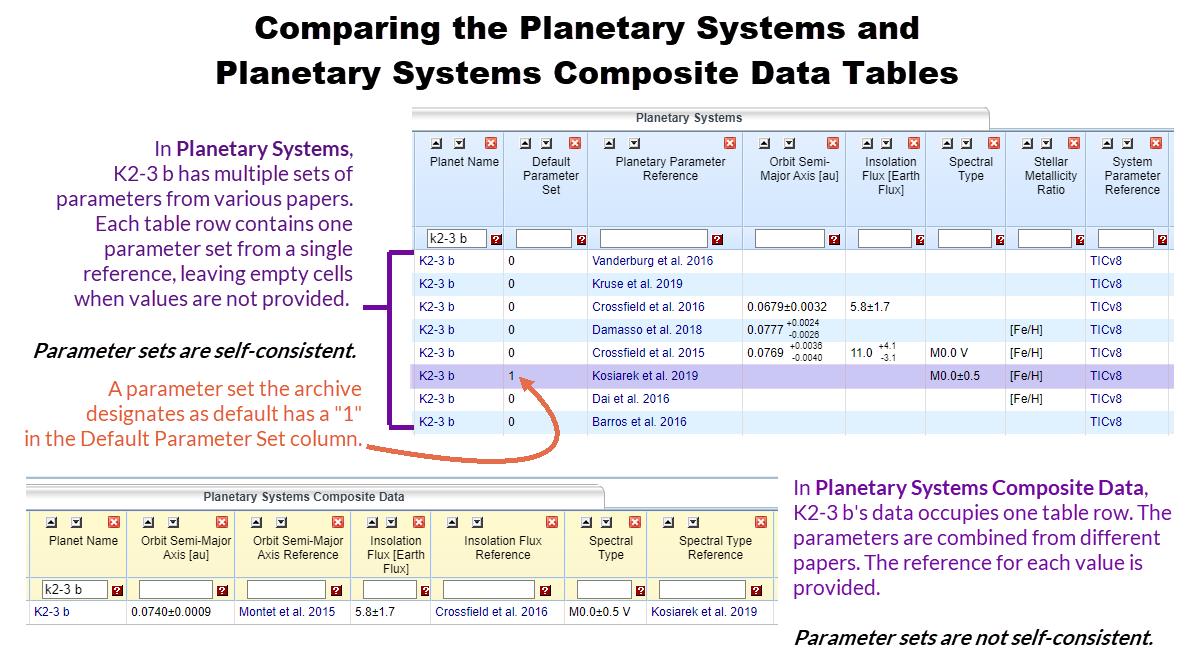About the Planetary Systems Composite Planet Data Table
The Planetary Systems Composite Parameters Planet Data table (PSCompPars) is a compilation of system, stellar, and planetary parameters for known Confirmed Exoplanets. The purpose of this table is to enable a more statistical view of the known exoplanet population and their host environments.
The NASA Exoplanet Archive collects and maintains many sets of parameters for planets, planetary orbits, and host systems as they are published in the refereed literature. The Planetary Systems Table table provides a single table view of the all of the ingested planetary systems for each known exoplanet with each row containing a self-contained set of parameters (planet + stellar + system) for each reference. The Planetary Systems table contains one row per planet per reference.
However, because any one reference may not provide a full set of derived stellar and planetary parameters, any one row in the Planetary Systems table is typically missing values, even though values may appear in other rows in the table. As a result, any one row in the Planetary Systems Table provides a self-consistent set of parameters for any one system, but each row is missing values because those parameters were not published with the planetary parameters.
The archive created the Planetary Systems Composite Parameters table to meet the needs of some users whose use cases require a more filled-in table with only one row per planet. This table provides a more complete, though not necessarily self-consistent, set of parameters. If you prefer only self-consistent sets of parameters for a specific planet, use the Planetary Systems table to access to all of the planetary system solutions in the archive for a given planet.
To access the Planetary Systems Composite Parameters table through the archive's Table Access Protocal (TAP) service—i.e., through an automated web or command-line query—see the TAP User Guide and Planetary Systems and Planetary Systems Composite Parameters Table Definitions document.
How the Composite Planet Data Table is Built
For any one planetary system, the Planetary Systems Composite Parameter table is populated in the following manner:
- Values are first selected from the default solutions in the Planetary Solutions table. (More information about how the archive designates parameter sets as default is in the FAQ.)
- If a value is not in the default parameter set (e.g., a planet radius is not reported in the default reference), values are chosen from the non-default default solutions in the Planetary Systems table. The secondary values are chosen from the most precise value; if a most precise value can not be uniquely identified, the most recent value is chosen. Priority is given first to measurements from published literature references, then to catalog references (e.g., TESS Input Catalog) if no literature references are available.
- If the Planetary Systems table does not have a value for the planetary radius, mass or density or a stellar luminosity, these values are calculated. See How the Archive Calculates Values in the Planetary Systems Composite Parameters Table for a detailed explanation.
When no mass or radius is available, we calculate these values with a mass-radius relationship. To filter out calculated values, click Select Columns and click either the Planet Mass or Msini Reference or Planet Radius Reference checkboxes, then Update. You may then filter the added column to not include calculated values by entering not like calculated value.
The following info graphic illustrates the differences between the Planetary Systems and Planetary Systems Composite Parameters tables: (Click to enlarge)
See also:
- Developing a More Integrated NASA Exoplanet Archive: How the archive's data tables and services are changing, and when.
- Archive 2.0 Release Notes
- Planetary Systems interactive table: The web version of the data table.
- Planetary Systems Composite Parameters interactive table: The web version of the data table.
- Interactive Table User Guide: How to access, sort, filter, plot and download table data.
- Planetary Systems Composite Parameters Table Calculations: How the archive calculates values in the Planetary Systems Composite Parameters table.
- Exoplanet Criteria: The archive's policy on including and excluding planets.
- Data Column Definitions: A detailed list and description of each parameter in both Planetary Systems tables.
- Table Access Protocol (TAP) User Guide: Build a a query to automate data downloads from the archive.
Last updated: 16 May 2023





